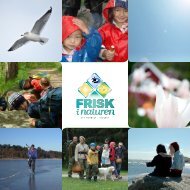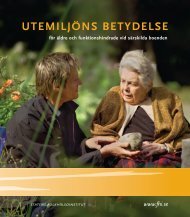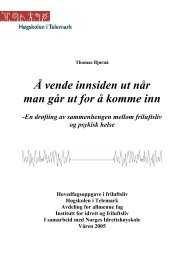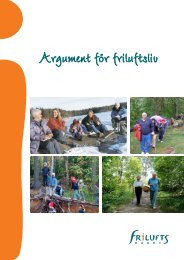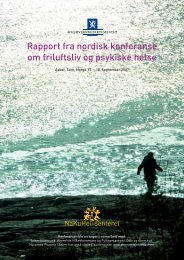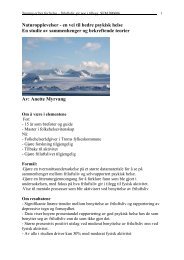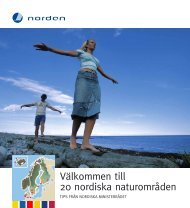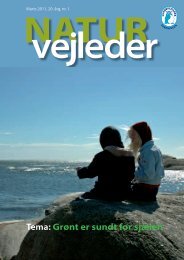Green Care: A Conceptual Framework - Frisk i naturen
Green Care: A Conceptual Framework - Frisk i naturen
Green Care: A Conceptual Framework - Frisk i naturen
Create successful ePaper yourself
Turn your PDF publications into a flip-book with our unique Google optimized e-Paper software.
ecotherapy has its legitimate origins in ecopsychology, it sits better within<br />
the more radical concept of ecohealth. The framework of ecohealth aims<br />
to achieve consensus and cooperation across all stakeholders, promoting<br />
approaches which are less costly than many medical treatments or primary<br />
health care interventions (Lebel, 2003) and which influence the broad<br />
spectrum of social systems, from community dwellers to decision-makers,<br />
about the value of ecosystem health as a crucial factor in public health.<br />
Contemporary ecotherapy can, therefore, be defined as an umbrella term<br />
for all nature-based methods aimed at the re-establishment of human<br />
and ecosystem reciprocal well-being; a transdisciplinary and ecosystemic<br />
approach aimed at the collaborative enhancement of physical,<br />
psychological and social health for people, communities and ecosystems.<br />
These outcomes are achieved through the development of a close personal<br />
and collective relationship with the natural ecosystem. The praxis of<br />
ecotherapy is based on a range of active interactions within multi-functional<br />
green spaces.<br />
4.6 Wilderness therapy<br />
Turning to nature and the wilderness for opportunities for personal<br />
awareness and personal change is not a new idea; the process has been<br />
in existence in human cultures for thousands of years. However, in more<br />
recent times the outdoors has been increasingly used to provide a range<br />
of personal development and wellbeing opportunities through immersion<br />
in natural, wild, and wilderness settings. Although the term ‘wilderness<br />
therapy’ is a relatively new concept in Europe, it has been in existence in<br />
the US for many years. Multiple definitions have evolved as the concept<br />
has gained popularity, but they all acknowledge a therapeutic process which<br />
is inherent in wilderness expeditions (Peacock et al, 2008).<br />
Davis-Berman and Berman (1994) initially defined wilderness therapy as<br />
“the use of traditional therapy techniques, especially for group therapy,<br />
in an out-of-doors setting, utilising outdoor adventure pursuits and other<br />
activities to enhance personal growth” (p.13). Crisp and O’Donnell (1998)<br />
define wilderness therapy as: “generic group therapy and group system<br />
models, inter-personal behavioural models, the experience of natural<br />
consequences, and modified group psychotherapy applied into a wilderness<br />
setting” (p.59). In more recent years, Connor (2007) has provided a more<br />
44 <strong>Green</strong> <strong>Care</strong>: A <strong>Conceptual</strong> <strong>Framework</strong>




